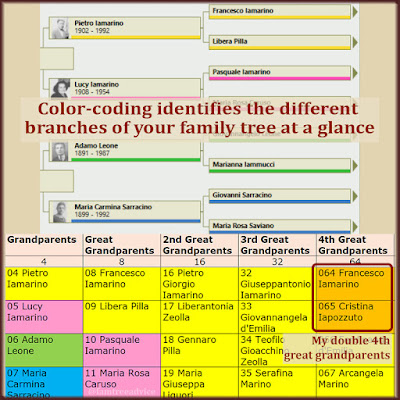When the family names and places aren't yours, how can you be sure it's them?
I wouldn't research my ex-in-laws at all if they weren't my sons' ancestors. But since they are, once in a while I check to see what else I can learn about them.
The main problem with researching your in-laws is the lack of familiarity. When it's your family, the names and places you discover are familiar. You can remember how Grandpa always mentioned the name of his hometown. You heard your mom talk about her great uncle living in a little room in her building.
But when it's not your family, you have so much less to go on. What can you do?
When my 1st son was born, I filled in a family tree chart in his baby book. My ex-mother- and father-in-law gave me the names for their side of the family. The baby-book chart only goes back as far as the baby's great grandparents. But it's a good start.
Here are 5 tips for building that less-familiar family tree.
 |
| One document after another, you can make progress on that in-law's family tree. |
1. Start With the Easy Documents
Try to find the latest census record you can for the family. For me, that's the 1940 census for each of my ex-husband's parents. (Let's call them ex-Mom and ex-Dad.) This is the first step to learning more about the families.
These census pages tell me where ex-Mom and ex-Dad lived in 1940 and 1935. They confirm ex-Mom's siblings' names and that ex-Dad was an only child. Now I have the approximate birth years and birth places of their parents.
Each tidbit of information gives clues to help find more documents. Keep building on each fact you learn.
 |
| An odd little memory came in handy when I found Uncle Anton. |
2. Try to Remember Details
One snippet of a memory proved to be very helpful. I remember visiting my ex-in-laws' vacation home in the 1980s. I went up to the attic to fetch something and saw an old hat. It was a black bowler hat with a sheen to it. Pinned to it was a piece of paper that said "Uncle Anton's hat".
Knowing there was an Uncle Anton helped me positively identify the family in the 1900 census. Both father and son were named Anton. Another son, John, was ex-Mom's father.
That meant I'd found another generation, plus siblings. And that led to many more documents.
 |
| A rock-solid bit of family lore—debunked! |
3. Investigate Family Stories
For years we thought ex-Dad's mother's uncle was Captain Smith who went down at the helm of the Titanic. I met ex-Dad's mom. This sweet old woman was deeply ashamed that her father Walter Smith's brother was the captain. My ex-Dad even belonged to a Titanic historic association.
When my son's school friends didn't believe he was related to Captain Smith, I said, "Now I know how to prove it." So I used my new genealogy research skills and quickly learned…wait for it…Captain Smith had no siblings! That is, he had only half-siblings whose last name was Hancock, not Smith.
What went wrong there? My ex-Dad came to realize the truth, but by then, his mom had passed away.
Have you heard any family stories with a single drop of historical fact you can investigate?
4. Follow the Paper Trail
Here's where you need to be careful. Without first-hand knowledge of the family, it will be impossible to be sure of some documents.
For example, take ex-Mom's maternal grandfather Edmund. The 1910 U.S. Federal Census says he arrived in America in 1889 and was naturalized by 1910.
I found an 1889 ship manifest with a man from Ireland who is the right age and has the right name. But ship manifests in 1889 don't offer much information. How can I be sure this is my guy? For now I've saved the URL of the manifest, but I haven't added it to my family tree.
The best way to prove I'm looking at the right Edmund is to find his naturalization papers. So far, I can't find those papers.
5. Seek Out Relatives
Of course you should never trust someone else's family tree if it has no sources. But you can use it for clues.
I found a relative with a published family tree. This took ex-Dad's paternal line back several generations. Using this tree as a guide, I searched for documents on Ancestry.com to prove whether the tree was right or wrong.
With this helpful tree, I went back as far as a set of 5th great grandparents for my sons.
If you use someone else's tree for its clues, be sure to cite the tree as a source. I'm happy when I can replace that family tree citation with a more formal source (like "England, Select Births and Christenings, 1538–1975"). But until you have proof in hand, add a citation so you know where you found this detail.
While you may never get as far on your in-laws side as you do on your own, you can do it justice. Use your skills to gather every piece of low-hanging fruit. And see where it leads you.
And speaking of following the paper trail:

















